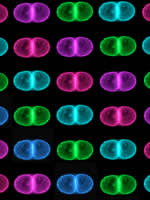UCSD Biologists Discover New Class of Genes Responsible for Embryonic Development
APRIL 30, 2001
By: Kim McDonald

Photo of pod-2 mutant embryo showing development of abnormal, symmetrical two-cell embryo marked with a fluorescent dye.
Credit: Akiko Tagawa, UCSD
Credit: Akiko Tagawa, UCSD
Biologists at the University of California, San Diego have discovered in the roundworm C. elegans a new class of genes necessary for the normal development of the earliest stages of embryonic development in animals.
In the May issue of the journal Developmental Biology, the UCSD researchers report the discovery of a new class of genes that regulates the asymmetric division of the first cell in the developing embryo into an unequal sized pair of cells.
"The actual mechanisms by which this happens are not well understood," says Raffi V. Aroian, an assistant professor of biology at UCSD who headed the research. "By understanding more about the genes that regulate this process, we can provide more information about one of the key questions in developmental biology-how complex organisms such as humans develop from a single-celled embryo."
In normal embryos, the larger of these cells develops into the outer layers of an organism, such as its skin and nervous system, while the smaller of the two cells develops into the inner portions, such as its muscle, gut and reproductive organs. When one of the genes in this new class is defective, however, the absence of differences between the two cells prevents the differentiation necessary for development.
"If the asymmetrical division is screwed up, the embryo is never going to make it," says Akiko Tagawa, a graduate student and the lead author of the paper, which also includes Chad A. Rappleye, another graduate student working in Aroian's laboratory. "It quickly dies."
In addition, the cells containing these mutant genes are vulnerable to bursting and shriveling. This is due to the inability of the defective embryo's cell membranes to maintain the cell's osmotic pressure, which can produce an undesirable flood of fluids into or out of the cells.
The UCSD scientists have dubbed their new class pod genes-for polarity and osmotic defective genes-because mutations in them result in embryos with defective osmoregulatory mechanisms and an inability to establish "polarity," the process by which developing embryos differentiate their cells during the first cell division.
Another set of genes known to regulate the polarity in the developing embryo is known as PAR, because mutations in these genes lead to errors in the partitioning of germline granules that, in a healthy embryo, all flow into the smaller of the first two dividing cells. First discovered in 1988, six PAR mutants have been identified in C. elegans and related genes have been found in frog, fruit fly and mammalian cells. Mutations in all of these genes, like mutations in the pod genes, result in symmetrical, two-celled embryos incapable of developing normally.
The first pod gene, pod-1, was discovered four years ago in Aorian's laboratory. The second, pod-2, discovered by Tagawa in a genetic screen, is described in the team's paper in this month's issue of Developmental Biology. Its discovery suggests that, like the six PAR genes discovered since 1988, many more pod genes will be found.
"This discovery has opened up for scientists a whole new class of genes critical for the earliest development of embryos," says Aroian. "Since a number of the genes in the C. elegans polarity pathway appear to play a role in the development of human cells, it is reasonable to think that pod genes may also play a role in human development."
In addition, Aroian speculates that pod genes may have an important role in the development of human cancers that arise because of problems in polarity. "Polarized epithelial cells give rise to 80 to 90 percent of cancers," he notes. "This class of genes may play an important role in that."
The UCSD team's research was supported by the National Science Foundation, the March of Dimes Birth Defects Foundation and the University of California's Cancer Research Coordinating Committee.
